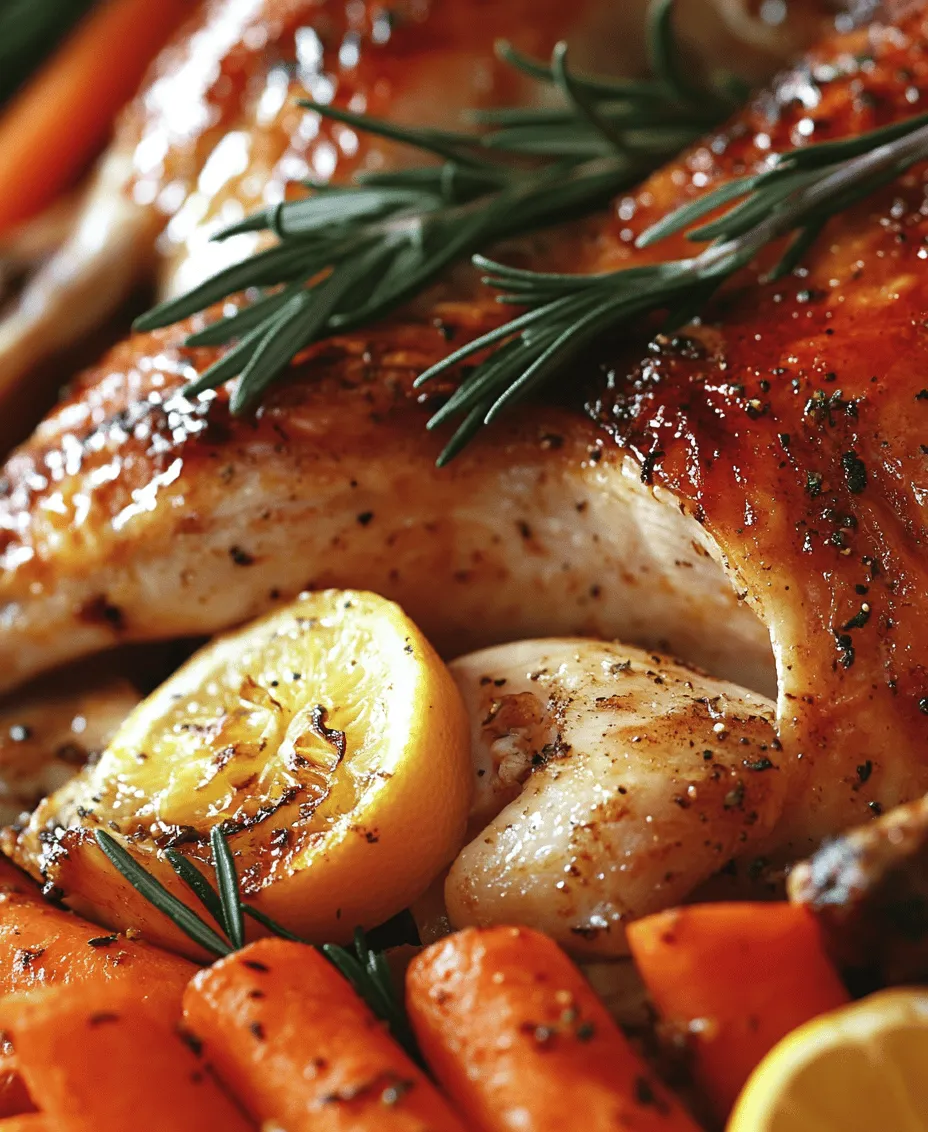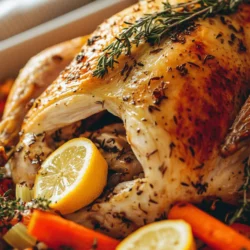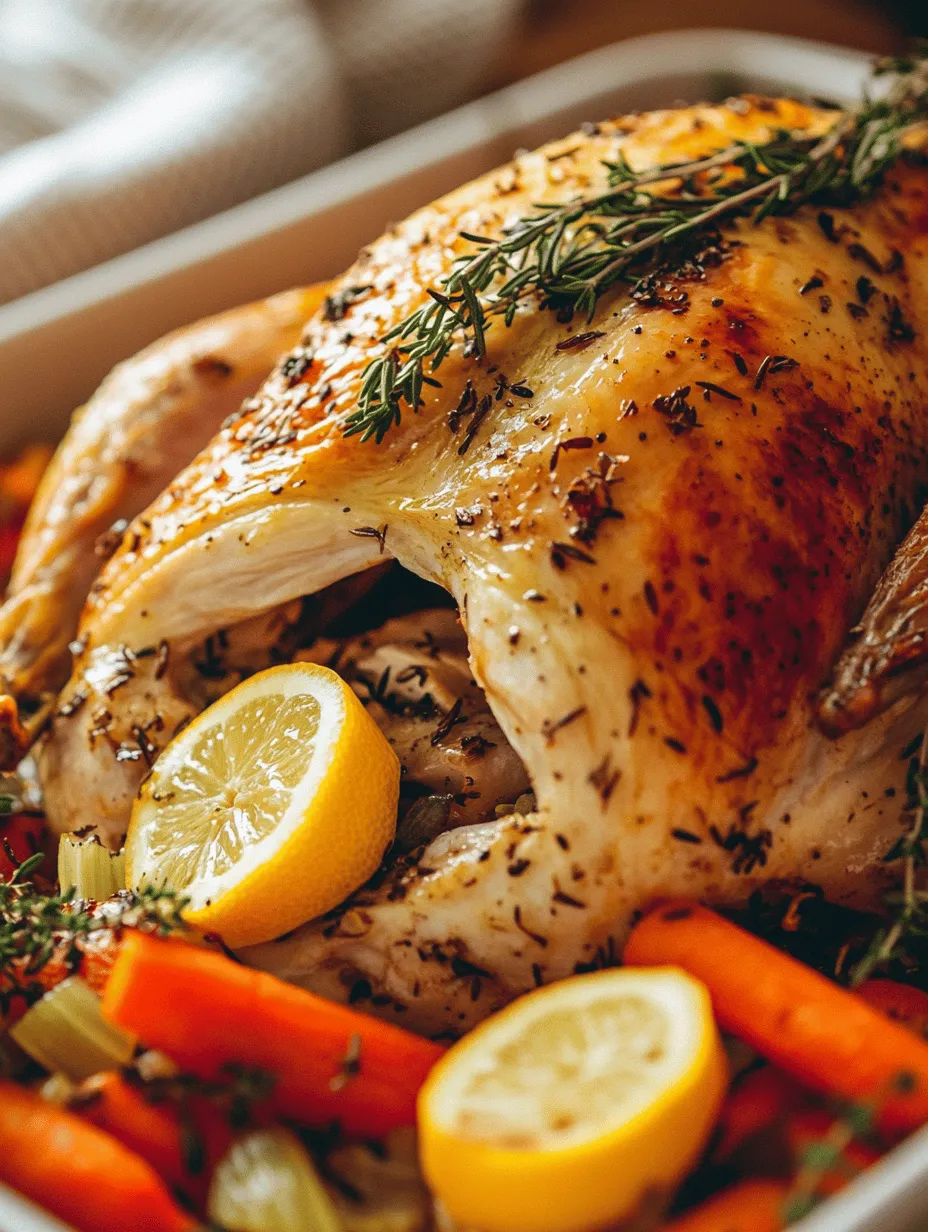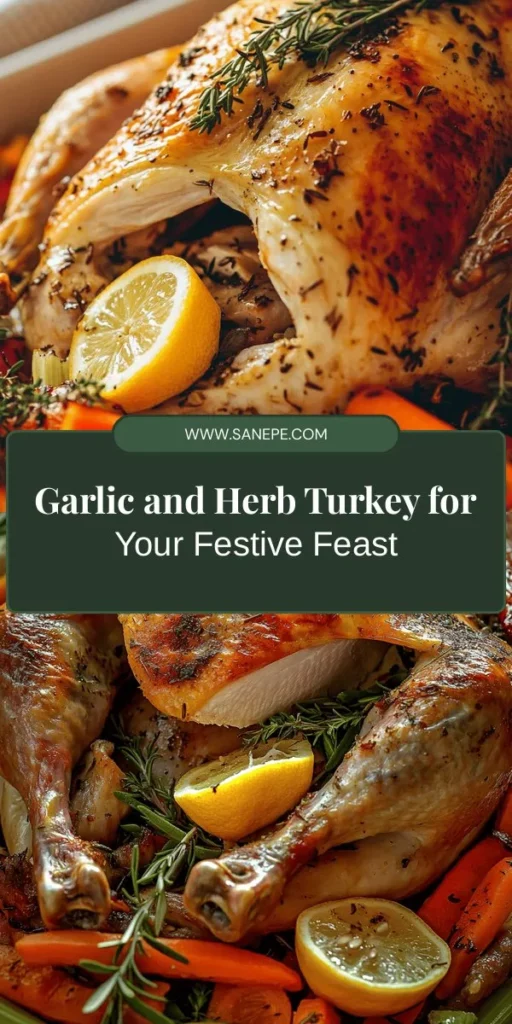Introduction
As the holiday season approaches, many families begin to plan their festive gatherings, and for most, the centerpiece of these celebrations is none other than a beautifully roasted turkey. Turkey has long been a symbol of abundance and gratitude, gracing dinner tables during Thanksgiving, Christmas, and various family celebrations around the world. Its rich flavor and succulent texture make it the perfect main course, and when prepared correctly, it can elevate any festive gathering to a memorable event.
This Garlic and Herb Turkey Recipe promises to be the star of your holiday table. Infused with aromatic herbs and savory garlic, this recipe not only enhances the natural flavors of the turkey but also ensures that it remains tender and juicy throughout the cooking process. Whether you are hosting a small family dinner or a large festive gathering, this turkey recipe is designed to impress your guests and leave them craving more.
The importance of flavor and tenderness in turkey preparation cannot be overstated. A well-cooked turkey should be moist, flavorful, and aromatic, with the herbs and garlic permeating deep into the meat. This recipe meticulously guides you through each step to ensure that your turkey emerges from the oven as a golden-brown masterpiece, ready to delight your family and friends.
Understanding the Ingredients
To create a truly unforgettable Garlic and Herb Turkey, it’s essential to understand the ingredients that contribute to its rich flavor and tenderness. Each component plays a vital role in the overall outcome, and selecting high-quality ingredients will greatly enhance your dish.
Whole Turkey
The first key ingredient is, of course, the turkey itself. When choosing a whole turkey, size matters. A general rule of thumb is to plan for about 1 to 1.5 pounds of turkey per person, ensuring that there is enough meat for everyone, along with some leftovers. Additionally, look for a fresh or frozen turkey that is free-range or organic, as these options tend to provide better flavor and texture. If opting for a frozen turkey, make sure to allow ample time for thawing in the refrigerator, as this can take several days depending on the size.
Butter
Butter is another crucial ingredient in this Garlic and Herb Turkey Recipe. It serves multiple purposes: adding rich flavor, contributing to moisture retention, and assisting with achieving that coveted golden-brown skin. Using unsalted butter allows you to control the salt content, making it easier to season the turkey to your liking. The butter will be blended with fresh herbs and garlic to create a flavorful herb butter that will be slathered all over and under the turkey’s skin.
Fresh Herbs
Fresh herbs are the heart of this recipe, with rosemary, thyme, sage, and parsley taking center stage. Each herb brings its unique flavor profile, enhancing the turkey’s natural taste. Rosemary offers a pine-like, earthy flavor, while thyme adds subtle floral notes. Sage provides a warm, slightly peppery taste, and parsley brings a fresh, bright flavor to balance the richness of the turkey. The combination of these herbs creates a fragrant herbaceous blend that elevates the turkey to new heights.
Garlic
Garlic is the secret weapon in this recipe, enhancing the umami and aromatic qualities of the turkey. Not only does it add a robust flavor, but garlic also works to tenderize the meat as it cooks, resulting in a juicy, flavorful turkey. Using fresh garlic cloves, minced or crushed, ensures that the flavor is potent and fragrant, permeating the turkey during roasting.
Lemons and Vegetables
Incorporating lemons and fresh vegetables, such as onions and carrots, into the roasting pan not only adds moisture but also infuses the turkey with a refreshing zest. The acidity of the lemons helps cut through the richness of the turkey, while vegetables caramelize as they roast, creating a delicious side dish that pairs well with the main course.
Low-Sodium Chicken Broth
Lastly, low-sodium chicken broth is instrumental in the cooking process. It helps to keep the turkey moist while adding depth of flavor. Using low-sodium broth allows you to control the overall saltiness of the dish, ensuring that the flavors from the herbs and garlic shine without being overpowered.
Preparation Steps for Success
To achieve the perfect Garlic and Herb Turkey, it is essential to approach the preparation with organization and care. Below are the key preparation steps that will set you up for success.
Prepping the Kitchen and Ingredients
A clean and organized kitchen is crucial when preparing a large meal like turkey. Begin by gathering all your ingredients and tools, including your roasting pan, basting brush, and meat thermometer. Ensure that your workspace is clear and sanitized to prevent cross-contamination. Having everything at hand makes the cooking process smoother and more enjoyable.
Thawing the Turkey Safely
If using a frozen turkey, ensure that you thaw it safely. The best method is to place the turkey in the refrigerator for several days, allowing it to defrost gradually. As a general guide, allocate about 24 hours of thawing time for every 4-5 pounds of turkey. If you’re short on time, a cold water method can be used: submerge the turkey in its original packaging in cold water, changing the water every 30 minutes. Regardless of the method, ensure the turkey is completely thawed before cooking, and always handle it with care to maintain food safety.
Crafting the Perfect Herb Butter
Creating Flavorful Herb Butter
The herb butter is the star of the show in this Garlic and Herb Turkey Recipe. To make it, start by softening the unsalted butter at room temperature. In a mixing bowl, combine the softened butter with minced garlic, and finely chopped fresh herbs—rosemary, thyme, sage, and parsley. The proportions can be adjusted to suit your taste, but a good starting point is about 1 tablespoon of each herb per half stick of butter. Incorporate some lemon zest for an extra layer of flavor and season with a pinch of salt and pepper.
Fresh Herbs vs. Dried Herbs
While dried herbs can be convenient, using fresh herbs in this recipe is highly recommended. Fresh herbs provide a vibrant flavor that dried herbs simply cannot match. Moreover, the texture and aroma of fresh herbs enhance the overall experience of the dish. If fresh herbs are unavailable, you can substitute dried herbs, but remember that the flavor will be less intense—use about one-third the amount of dried herbs compared to fresh.
Preparing the Turkey
Once your herb butter is ready, it’s time to prepare the turkey for roasting.
Cleaning and Drying the Turkey
Start by removing the turkey from its packaging and discarding any giblets or neck that may be inside the cavity. Rinse the turkey under cold water and pat it dry with paper towels. Drying the turkey is essential, as this helps to achieve crispy skin during roasting.
Buttering the Turkey
With the turkey clean and dry, it’s time to apply the herb butter. Carefully loosen the skin of the turkey, starting at the neck and working your fingers down toward the breast. Be gentle to avoid tearing the skin. Use your fingers or a small spatula to spread the herb butter directly onto the meat under the skin. This method allows the flavors to penetrate the meat as it cooks, ensuring a beautifully aromatic and flavorful turkey. Once you’ve buttered the breast, repeat the process on the thighs and drumsticks for maximum flavor.
Roasting Techniques for a Perfectly Cooked Turkey
Importance of Trussing the Turkey
Trussing is the process of tying the turkey’s legs together and securing the wings against the body. This technique not only helps the turkey cook evenly but also ensures that it maintains its shape during roasting. A well-trussed turkey looks more appealing when served and prevents the tips of the wings from burning. To truss your turkey, use kitchen twine to tie the legs together, and tuck the wing tips under the body.
Setting Up the Roasting Pan
Preparing the roasting pan is the final step before placing your turkey in the oven. Choose a sturdy roasting pan that is large enough to accommodate the turkey comfortably. For optimal heat distribution, consider placing a rack inside the pan to elevate the turkey. This allows hot air to circulate around the turkey, promoting even cooking. Additionally, place chopped vegetables and lemon halves in the bottom of the pan; these will infuse moisture and flavor into the turkey as it roasts.
With these preparation steps completed, you are ready to move on to the roasting phase, where the magic truly happens. The combination of garlic, fresh herbs, and careful preparation will yield a spectacular Garlic and Herb Turkey that will leave your guests raving about your culinary skills.

Garlic and Herb Turkey Recipe – The Perfect Festive Delight
Importance of Vegetables in Creating a Flavorful Base
A flavorful base is essential for achieving a moist and delicious turkey, and the key to that base lies in the vegetables you choose. Onions, carrots, celery, and garlic form the aromatic foundation that enhances the natural flavors of the turkey. When roasted alongside the turkey, these vegetables caramelize, infusing the meat with their savory essence. They not only contribute to the flavor but also create a rich broth that can be used for gravy or as a flavorful sauce.
As you prepare your Garlic and Herb Turkey, consider chopping these vegetables into large chunks and placing them in the roasting pan. This will not only add depth to the flavor but also help with moisture retention during the roasting process.
Roasting Process
Roasting a turkey might seem daunting, but with the right techniques and attention to detail, you can achieve a beautifully browned, succulent bird. Here’s how to roast your Garlic and Herb Turkey to perfection:
Detailed Roasting Instructions
1. Preheat the Oven: Begin by preheating your oven to 325°F (163°C). This moderate temperature allows for even cooking while ensuring the outer layer does not burn before the inside is fully cooked.
2. Prepare the Turkey: Once the turkey is seasoned and stuffed (if desired), place it on a rack in a roasting pan. This allows for air circulation and promotes even cooking. For additional flavor, consider adding fresh herbs like rosemary, thyme, and sage inside the cavity.
3. Roasting Time: The general rule of thumb is to roast the turkey for about 13-15 minutes per pound. For example, a 14-pound turkey will take approximately 3 to 3.5 hours to cook. Keep in mind that cooking time may vary based on your oven, so it’s essential to monitor the turkey closely.
4. Basting: Basting your turkey is crucial for maintaining moisture and enhancing flavor. Every 30 minutes, use a baster or a large spoon to drizzle the pan juices over the turkey. This helps to keep the skin crispy while ensuring the meat remains juicy.
Techniques to Avoid Over-Browning
While a beautifully golden-brown turkey is desirable, over-browning can lead to a dry outer layer. To prevent this, consider placing a loose sheet of aluminum foil over the turkey if it begins to brown too quickly. This will shield the skin from direct heat while allowing the turkey to continue cooking evenly. Remove the foil during the last 30 minutes of roasting to achieve that sought-after golden color.
Checking for Doneness
Understanding when your turkey is perfectly cooked is essential for a successful meal.
Understanding Internal Temperatures
Using a meat thermometer is the most reliable way to check for doneness. The USDA recommends an internal temperature of 165°F (74°C) for turkey.
1. Where to Measure: Insert the thermometer into the thickest part of the thigh, avoiding the bone, as this can give a false reading. For stuffed turkeys, also check the temperature in the center of the stuffing.
2. Visual Cues: Aside from temperature, look for clear juices running from the turkey. If the juices are pink, the turkey needs more time to cook. Additionally, the legs should move freely in their sockets, indicating that the meat is tender.
Recognizing Signs of a Perfectly Roasted Turkey
Once your turkey reaches the recommended temperature, there are several visual cues to confirm that it is perfectly roasted. The skin should be a deep golden brown, and the meat should appear firm yet juicy.
Resting and Serving the Turkey
The Importance of Resting the Turkey
After removing the turkey from the oven, allow it to rest for at least 20-30 minutes before carving. This is vital for retaining the juices within the meat. If you carve immediately, the juices will run out, resulting in a dry turkey.
Carving Tips for Presentation
1. Gather Your Tools: You will need a sharp carving knife, a carving fork, and a cutting board.
2. Carving Steps:
– Place the turkey on the cutting board, breast side up.
– Start by removing the legs and thighs. Cut through the skin that connects them to the body and then remove them by pulling them away from the turkey.
– Next, slice along the breastbone to free the breast meat. Cut the breast meat into thin slices against the grain for tenderness.
3. Presentation: Arrange the sliced turkey attractively on a serving platter. Consider garnishing with fresh herbs or the roasted vegetables used during cooking for an appealing presentation.
Pairing Suggestions for a Festive Feast
Recommended Side Dishes
A Garlic and Herb Turkey pairs well with a variety of classic side dishes. Here are some suggestions:
– Garlic Mashed Potatoes: Creamy, buttery mashed potatoes infused with roasted garlic complement the turkey’s flavors beautifully.
– Green Bean Almondine: Sautéed green beans with almonds provide a crunchy contrast to the tender turkey.
– Stuffing or Dressing: A savory stuffing made with bread, herbs, and vegetables can be cooked alongside the turkey or separately.
– Cranberry Sauce: The tartness of cranberry sauce cuts through the richness of the turkey, adding a refreshing element to the meal.
Beverage Pairings
Choosing the right beverages enhances the festive atmosphere and complements the meal. Consider these options:
– Wine: A medium-bodied red wine, such as Pinot Noir or Merlot, pairs well with turkey and its flavors. For white wine lovers, a Chardonnay can also complement the dish nicely.
– Non-Alcoholic Options: Sparkling apple cider or a festive punch made with seasonal fruits can be a delightful addition for guests who prefer non-alcoholic beverages.
Conclusion
The Garlic and Herb Turkey is a centerpiece that embodies the spirit of festive gatherings. Its aromatic herbs and garlic infuse the meat with flavors that resonate with tradition and celebration. Embrace the cooking process, savoring each step as you prepare to share this delightful dish with your loved ones.
Cooking a turkey can be a rewarding experience filled with joy, laughter, and the warmth of family and friends. So, gather around the table, enjoy the fruits of your labor, and create lasting memories with those you cherish most during special occasions.


